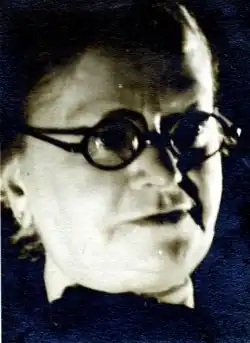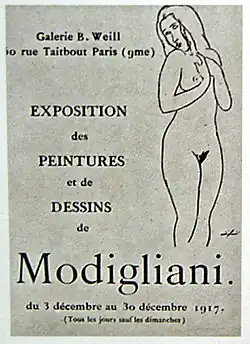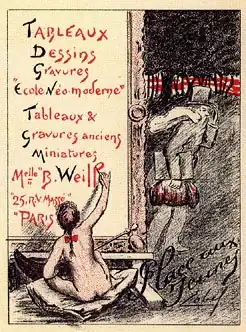Berthe Weill
Berthe Weill | |
|---|---|
 | |
| Born | Esther Berthe Weill 20 November 1865 |
| Died | 17 April 1951 (aged 85) |
| Occupation | Art dealer |
| Organization | Galerie B. Weill |
Berthe Weill (1865–1951) was a French art dealer who played a significant role in shaping the early 20th century French art market. She is recognized as the first-and to date the only, female art dealer known to have promoted the avant-garde at the beginning of the 20th century.[1][2][3]
Early life and education
Esther Berthe Weill was born on the 20 November 1865 in Paris to Jeanny Lévy, a seamstress, and Salomon Weill, a textile trader.[4][5][6] Part of a lower middle class Alsatian Jewish family, Weill was the fifth of seven children.[3][5]
Weill attended school up to the age of 10.[6]
Career
Apprenticeship
In the 1880s, Weill began an apprenticeship at Salvador Mayer’s antique shop on the Rue Laffitte.[3][7] During her apprenticeship, Weill was introduced to the art critic Claude Roger-Marx, through whom she developed an interest in the art of the new young painters.[2][5]
Following Mayer's death in 1897, Weill opened a short lived gallery on the rue Victor-Massé with brother Marcellin.[3][5]
Galerie B. Weill
In October 1900, the Catalonian art dealer Pere Mañach introduced Weill to Pablo Picasso.[3][8]
On December 1, 1901, Weill used part of her dowry to open "Galerie B. Weill" at 25 rue Victor Massé, calling it a place for the young.[8] There she bought and sold modernist works of art, largely Fauvist and Cubist. She did not amass a large collection, nor focus in on a particular style or set of artists, causing many artists to switch to more financially stable dealers as their careers progressed. In 1908 and 1909, she exhibited works by Fauves including Braque, Derain, Manguin, Marquet, Marval and Matisse.[3] In 1913, she curated a show with works by Gleizes, Léger and Metzinger. She hosted a group exhibition with works by and Gleizes, Léger, and Picasso.[3]

Galerie Berthe Weill changed locations in 1917, from 25 rue Victor-Massé to 50 rue Taitbout, then again in 1919 to 46 rue Laffitte, in the former gallery of Clovis Sagot. At the same time, Weill inaugurated her "librairie artistique" and launched her publication titled Bulletin.[9]
In 1933, Weill published her memoirs, an account of thirty years as an art dealer, from which many historical renditions quote.[10]
In 1941, rising antisemitism and the outbreak of World War II forced her to close her gallery.[8]
In 1946, several painters whose work she had promoted over the years organised an auction of donated artworks, with the proceeds used to support her in later life.[11] An estimated 1.5 million francs was raised (equivalent to $147,000 in 2025), which supported Weill until her death.[6]
In 1948, the Republic of France recognized her as a Chevalier de Légion d'Honneur, for her contribution to Modern Art.[11]: 11
In 1951, Weill died at the age of 86. Although she received some recognition during her lifetime, she was largely either misunderstood or given only brief mention in historical accounts of the period, until renewed interest in her work emerged in recent years.[6]
Artists
Weill's gallery included works by artists such as Raoul Dufy, André Derain, Maurice de Vlaminck, Diego Rivera, Georges Braque, Kees van Dongen, Maurice Utrillo, Pablo Picasso, François Zdenek Eberl and Jean Metzinger. Her role was also important in the early exposure and sales of women painters such as Suzanne Valadon, Emilie Charmy and Jacqueline Marval.[12] "Of the nearly 400 exhibitions she mounted, one third included works of art by women artists," wrote the New York Times in 2024.[13]
Her gallery also included works by Picasso, Matisse, Jeanne (Jane) Rosoy, Derain, Vlaminck, Marquet, Manguin, Camoin, Raoul Dufy, Diego Rivera, Braque, Friesz, van Dongen, Utrillo, Puy, Metzinger, Odette Des Garets, Modigliani, Rouault, Marie Laurencin, Suzanne Valadon, Emilie Charmy, Kisling, Flandrin, Léger, Pascin, Georges Kars,[14] and Émilie Charmy.[13]
Collectors

- Adolphe Brisson, Literary Critic for Temps
Picasso's first sales in Paris were three pastels on canvas depicting bullfighting scenes, which Weill sold to him in 1900.
- Arthur Huc, Director of La Dépêche de Toulouse. Weill sold Le Moulin de la Galette (1900) to Arthur Huc. According to John Richardson, Huc was "one of the most progressive collectors of the day". Later this painting was bought by Justin Thannhauser who donated it to the Guggenheim Museum (NY).[15]: 168
- Franz Jourdain, Architect of the Samaritaine Department Store, first president of the Salon d'Automne ; in 1902, Weill sold a Marquet to him.[2]
- André Level, Head of the consortium of investors who, in 1904, began forming the Peau de l'Ours art collection of twentieth-century art. In 1914, it was sold at auction and was notable for its "phenomenal financial success". Weill stated that three-quarters of the items in the collection were purchased from her gallery. While this figure may be an exaggeration, Level is known to have bought from her regularly.[16]: 26–27 [10]: 194
- Gertrude and Leo Stein, American expatriates living in Paris who played a pivotal role in promoting and collecting avant-garde art
- Olivier Saincère, Counsellor of State and future secretary general of the Élysée under Raymond Poincaré, one of Weill's first collectors.
- Gustave Coquiot, French writer and art critic, collector of Maurice Utrillo.
- Sergei Shchukin, Russian collector from Moscow.[15]: 389–393
Legacy
An exhibition on Weill's legacy opened at New York University's Grey Art Museum in October 2024.[17][13]
In recent years, interest in Berthe Weill has become more significant.[16] In 2007, Picasso's portrait of Berthe Weill (1920) was designated a French national treasure.[11]: 11 In 2009, her memoirs (1933) were republished[18] and a compilation of her gallery exhibitions;[11] in 2011, the first study dedicated to her life and dealership was published by leading Weill scholar Marianne Le Morvan.[19] In February 2012, the City of Paris decided to place a memorial plaque at 25 rue Victor Massé (Paris), where Berthe Weill opened her first gallery in 1900.[20]
References
- ^ "Weill, Berthe (1865-1951) forme internationale". BnF Catalogue Général (in French). Paris: Bibliothèque nationale de France. 2015. Retrieved 9 August 2025.
- ^ a b c Elderfield, John (1976). The Wild Beasts': Fauvism and Its Affinities (PDF). New York City; Oxford: The Museum of Modern Art; Oxford University Press. ISBN 0-87070-639-X. Retrieved 9 August 2025.
- ^ a b c d e f g Tasseau, Vérane (2015). "Berthe Weill". The Modern Art Index Project, Leonard A. Lauder Research Center. New York City: The Metropolitan Museum of Art. doi:10.57011/EHXL9424. Retrieved 9 August 2025.
- ^ "Esther Berthe Weill", État-Civil 1792-1902 (in French) (01er arrondissement, 1865, Naissances), Paris: Archives de Paris, 1865
- ^ a b c d Dellheim, Charles (2021). "Meet Berthe Weill, the Groundbreaking Female Art Dealer Who Made a Name for Picasso". Literary Hub. New York City: Literary Hub. Retrieved 9 August 2025.
- ^ a b c d Cole, Rachel (June 7, 2025). Zelazko, Alicja (ed.). "Berthe Weill". Encyclopedia Britannica. Retrieved 10 August 2025.
- ^ "Salvador Mayer". Collection online. London: British Museum. Retrieved 9 August 2025.
- ^ a b c Chernick, Karen (2020-02-07). "The Forgotten Female Art Dealer Who Championed Picasso and Modigliani". Artsy. Retrieved 2020-03-07.
- ^ Marie Perennes. Éditer, exposer : nouvelles médiations artistiques à Paris dans l’entre-deux-guerres. Histoire. 2014. ffdumas-01071653
- ^ a b Weill, Berthe. "Pan ! Dans L'œil! Ou trente ans dans les coulisses de la peinture contemporaine 1900-1930", Lipschutz, Paris 1933
- ^ a b c d Sanchez, Pierre, "Les expositions de la Galerie Berthe Weill (1901-1942) et de la Galerie Devambez (1907-1926) Repertoire des artistes et liste de leurs œuvres", II, L'Échelle de Jacob, Dijon, 2009
- ^ Perry Gill. "Women Artists and the Parisian avant-garde: Modernism and 'feminine' art, 1900 to the late 1920s", Manchester University Press, Manchester and New York", 1995
- ^ a b c Sheets, Hilarie M. (October 2, 2024). "The Forgotten Dealer Who Discovered Picasso and Matisse". The New York Times. Vol. 173, no. 60295. pp. C1, C7.
- ^ Le Morvan, Marianne. "List of exhibited artists at the B.Weill Gallery". bertheweill.com. Archived from the original on 2019-03-10.
- ^ a b Richardson John, "A Life of Picasso: The Early Years, Vol. I, 1886-1906", Random House, 1991
- ^ a b FitzGerald Michael, "Making Modernism: Picasso and the Creation of the Market for Twentieth-Century Art", Farrar, Straus and Giroux, New York", 1995, "[1]"
- ^ "Make Way for Berthe Weill: Art Dealer for the Parisian Avant-garde, October 1, 2024–March 1, 2025". New York University: Grey Art Museum. Retrieved October 2, 2024.
- ^ Weill, Berthe, "Pan ! Dans L'œil ! Ou trente ans dans les coulisses de la peinture contemporaine 1900-1930", L'Échelle de Jacob, 2009 (Préface by François Roussier de la Tronche)
- ^ Le Morvan, Marianne, "Berthe Weill 1865-1951 La petite galeriste des grands artistes", L'Écarlate, Orléans, 2011
- ^ "Decision by the Council of Paris to install a "plaque commémorative" at 25, rue Victor Massé". Archived from the original on 2016-01-06. Retrieved 2012-07-01.